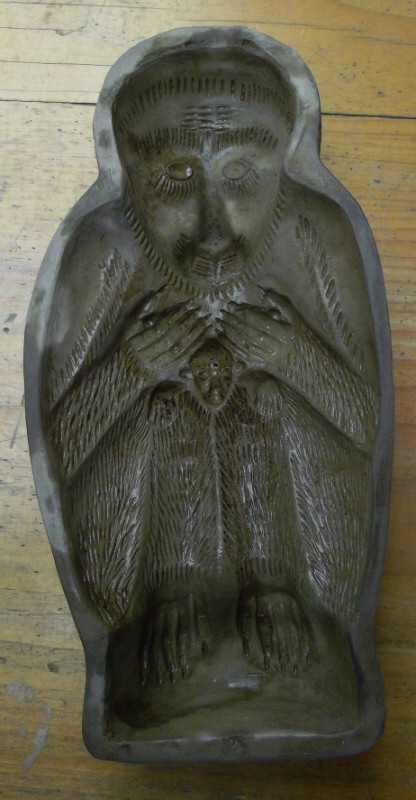
Chango Mezcalero bottle mould
|
 Chango Mezcalero bottle mould |
History of Chango Mezcalero in Oaxaca; Of Monkeys and Mezcal
The monkey has long been associated with drunkenness. And so it didn't take a leap of faith for someone to combine monkeys with relatively high alcohol content mezcal, and thus bring together primate and spirit.
The story, significance and different representations of chango mezcalero, and the competing claims to being the originator of the mezcal bottle, have been documented elsewhere. To briefly recap the controversy, two families in San Bartolo Coyotepec, descendants of the late Marcelo Simón Galán and of the late Juventino Nieto, have each claimed that their respective ancestors first created chango mezcalero. And of course it's been suggested that other artisans, whether in the same village just outside of Oaxaca, or in other regions or states in Mexico, may have been the founders of the art form.
Hunt for First Chango Mezcalero Molds in San Bartolo Coyotepec, Oaxaca
A few months before his death in May, 2010, Don Valente, Don Juventino's sole surviving child, indicated that he indeed still retained his father's original chango mezcalero molds. But Don Valente's unexpected death preceded his ability to look for them. A year later one of his sons and daughters-in-law each individually promised to do his/her best to rummage through all the old boxes of their father and grandparents with a view to finding the clay mezcal bottle molds. Don Juventino died in 1973, and Doña Rosa in 1980, so a lot of dust had accumulated on presumably a mounting number of boxed keepsakes - including the chango mezcalero molds.
Chango Mezcalero Molds More Generally
There are numerous chango mezcalero molds in existence throughout Oaxaca and perhaps even in other Mexican states. The true age of the clay mezcal bottles produced with them is difficult to ascertain. It's trite to note that in the world of antiques and collectibles, there are industries build around making and marketing a vast variety of products intended to appear vintage and well worn. Chango mezcalero may be no different, although there does not appear any deliberate attempt to misrepresent (except of course perhaps via internet sales).
Don Valente himself made decorative chango mezcalero clay figures using one or more different molds. But at least some of those of Don Valente had an open bottom and were therefore not functional for holding mezcal. They were apparently never painted like many of the older utilitarian chango mezcaleros. Most of the latter were painted on their backs with the words Recuerdo de Oaxaca (Souvenir of Oaxaca), and some were personalized on the front, to be given as gifts. At least one plastic version of chango mezcalero exists.
Discovery of Chango Mezcalero Molds Provisionally Resolves Art Form Mystery Two molds have been uncovered, tucked away amongst boxes of coveted possessions of Doña Rosa and Don Juventino. One is dated July 12, 1938. It's in excellent condition, both sides fully intact. Without any doubt is was used to produce functional clay chango mezcalero bottles for holding mezcal, since an opening for a cork appears at the top of each side, and the bottoms fit tightly together. While this suggests that the mold was intended for utilitarian purposes, of course it would also have had decorative value.
The second, a somewhat larger mold, is only of the face side of the monkey, the back having been lost or destroyed. Its age appears the same as the smaller dated mold. However this mold is damaged, a sizeable piece of one of the monkey's legs having been chipped off. In addition there is no opening at the top suggesting it may not have been used to make bottles for holding mezcal. On the other hand, the missing back side may have very well contained a full opening at the top, suitable for corking the chango's alcoholic contents.
The Chango Challenge Continues Amongst Collectors of Vintage Mexico and Aficionados of Mezcal
These finds go a long way to resolving two pressing questions relating to the origins of the chango mezcalero used in the marketing and sale of mezcal in Oaxaca; the identity and place of residence of the originator of chango mezcalero, and when the art form first appeared on the shelves of workshops, cantinas and residences.
But further versions of the history of chango mezcalero will likely continue to emerge, even in the face of unearthing additional evidencein support of the current theory, or opposing it. But until then, let's lay chango mezcalero on its back to rest, and leave his spirit intact.
Alvin Starkman is an aficionado of both mezcal and pulque, and a collector of vintage objects and antiques. He takes visitors to Oaxaca to visit small rural mezcal "factories" and into the fields to harvest aguamiel. Alvin has written over 250 articles about Oaxacan life and cultural traditions. He and his wife Arlene operate Casa Machaya Oaxaca Bed & Breakfast.